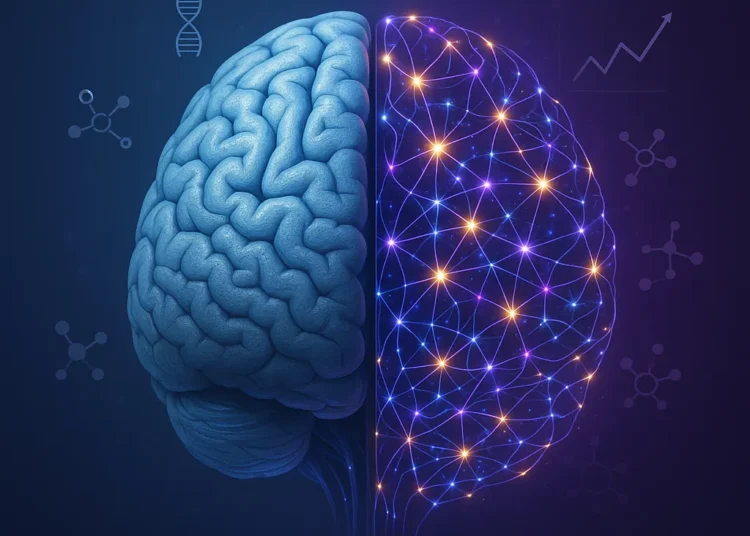Executive Summary
For decades, neuropsychiatry was a field characterized by high failure rates and incremental progress, making it a challenging landscape for investors. Today, that narrative has fundamentally changed. A powerful convergence of novel science, significant capital investment, and streamlined regulatory pathways is creating an unprecedented opportunity. After a long period of stagnation, 2025 marks a pivotal moment for the sector.
The key driver of this shift is a new class of therapies, including psychedelic-based compounds and rapid-acting antidepressants, which are demonstrating remarkable efficacy for treatment-resistant conditions like Major Depressive Disorder (MDD). This scientific validation has unlocked a torrent of capital, with venture funds and strategic partners now pouring into the space. Investment risk is being mitigated by critical innovations in clinical trial design and AI-driven drug discovery, making development more predictable. Furthermore, regulatory mechanisms like the FDA’s Breakthrough Therapy Designation are accelerating the path to market for the most promising treatments. The central conclusion is clear: the neuropsychiatry sector in 2025 represents a unique inflection point for strategic investment, propelled by validated science and undeniable market momentum.
Introduction
For decades, mental health treatment has been defined by incremental advances and high failure rates, leaving investors wary and millions of patients in need. The complexity of the brain has made psychiatric drug development one of the most challenging frontiers in medicine. But what if the code to unlocking the brain’s complexities—and a multi-billion dollar market—is finally being cracked? The field of neuropsychiatry is currently undergoing a profound transformation, moving from an era of stagnation to one of explosive innovation.
This analysis synthesizes findings from leading institutional reports, clinical trial data, and financial market trends to provide a comprehensive, data-driven view of this new landscape. We will draw on direct industry experience, including the trajectory of pioneering companies like Cybin, to illustrate the powerful forces at play. This is not a high-level academic overview or a shallow marketing piece. It is a definitive 2025 insider’s guide for investors, executives, and researchers who need to understand the tangible opportunities emerging from this renaissance. In the following sections, we will deconstruct the science behind the latest breakthroughs, map the investment landscape fueling this growth, analyze the regulatory catalysts accelerating development, and explore the innovations that are finally solving historical R&D challenges.
Table of Contents
- The New Neuropsychiatry Landscape: Why 2025 is a Tipping Point
- The Science Driving the Shift: A Deep Dive into Breakthrough Therapies
- The Capital Catalyst: Mapping the Neuropsychiatry Investment Landscape
- The Regulatory Gateway: Understanding the FDA’s Role in Accelerating Innovation
- Overcoming R&D Hurdles: The Innovations De-Risking Investment
- Conclusion
- FAQ: In-Depth Questions on Neuropsychiatry in 2025
The New Neuropsychiatry Landscape: Why 2025 is a Tipping Point
To understand the magnitude of the current opportunity, one must first appreciate the history of psychiatric drug development. The sector is emerging from a long “drought” and entering a new era defined by a powerful convergence of factors that make 2025 a clear tipping point for innovation and investment.
From Stagnation to Innovation: A Brief History
The last great wave of psychiatric drug discovery, which produced the SSRIs that still dominate treatment paradigms, occurred decades ago. Since then, progress has been slow and fraught with failure. A 2022 report from the Tufts Center for the Evaluation of Value and Risk in Health highlighted the significant barriers to innovation in mental health, including the immense cost and low probability of success in clinical trials, a poor understanding of the biological basis of many disorders, and a lack of reliable biomarkers. This environment led many large pharmaceutical companies to scale back their neuropsychiatry research programs, creating a void in development. The intersection of behavioral neurology and neuropsychiatry lacked the tools to translate brain insights into effective medicines, leaving a massive unmet medical need.
The Convergence: Science, Capital, and Regulation
Today’s landscape is radically different. The current momentum is not the result of a single factor but the powerful intersection of three reinforcing trends. This is why many are calling this a neuropsychiatry a comprehensive update for the entire field.
-
Science: Researchers have moved beyond simply targeting serotonin and dopamine. A deeper understanding of neural circuitry and brain plasticity has led to the development of therapies with novel mechanisms of action, showing rapid and durable effects in patients who have not responded to existing treatments.
-
Capital: The compelling clinical data emerging from this new science has captured the attention of sophisticated investors. Venture capital, private equity, and strategic partnerships are flooding the sector, providing the necessary fuel to advance promising compounds through costly clinical trials.
-
Regulation: Recognizing the urgent need for better treatments, regulatory bodies like the U.S. Food and Drug Administration (FDA) have created accelerated pathways for promising drugs. Designations that speed up review and development are de-risking the process for innovators in clinical neuropsychiatry.
The Science Driving the Shift: A Deep Dive into Breakthrough Therapies
The engine of this new era in neuropsychiatry is a wave of scientific discovery that is fundamentally changing our approach to treating mental illness. By targeting novel pathways and mechanisms, these therapies offer hope where previous treatments have failed.
Beyond SSRIs: The New Mechanisms of Action
For years, the treatment of depression has been dominated by selective serotonin reuptake inhibitors (SSRIs), which can take weeks or months to work and are ineffective for up to a third of patients. The new generation of therapies operates on entirely different principles. Rapid-acting antidepressants, such as NMDA receptor modulators, are showing the ability to produce significant antidepressant effects within hours or days, not weeks. This represents a paradigm shift in clinical neuropsychiatry, moving from chronic administration to acute, targeted intervention. This focus on the biological underpinnings of mental disorders, often referred to as organic psychiatry, is yielding treatments for conditions like Treatment-Resistant Depression (TRD) and Major Depressive Disorder (MDD) with unprecedented speed and efficacy.
The Psychedelic Renaissance: From Taboo to Targeted Therapy
Perhaps the most significant area of neuropsychiatry research is the clinical application of psychedelic-based compounds. Once relegated to the fringes, substances like psilocybin and DMT are now at the forefront of therapeutic development for their ability to promote neural plasticity and rapidly reset pathological brain circuits. The innovation has moved far beyond the raw compounds themselves. Companies are now engineering novel analogs to optimize the therapeutic experience. For instance, deuterated psilocybin analogs are designed to have a more predictable and controlled effect, potentially offering a shorter duration of action and improved safety profile. This refinement is critical for clinical adoption and scalability. Cybin’s lead candidate, CYB003, is a prime example of this next-generation approach, leveraging advanced chemistry to create a potentially superior therapeutic for MDD.
The Capital Catalyst: Mapping the Neuropsychiatry Investment Landscape
Scientific breakthroughs alone are not enough; they require substantial capital to translate into approved therapies. The recent surge in investor confidence and strategic funding is the catalyst turning scientific promise into market reality.
Market Growth and VC Trends
The global neuropsychiatry market is projected to grow significantly over the next decade, driven by the immense unmet need and the promise of novel therapeutics. This potential has not gone unnoticed by the investment community. Venture capital funding for mental health technology and biotechnology companies has exploded over the last five years. Deal sizes have increased, and funding rounds are attracting top-tier investors who now see a clear, de-risked path to value creation. These investment opportunities are no longer seen as speculative long shots but as a core component of a forward-thinking life sciences portfolio. Market analysis consistently points to a sustained upward trend in capital allocation to companies developing treatments for depression, anxiety, and other psychiatric conditions.
Key Players and Competitive Dynamics
The competitive ecosystem is dynamic and comprised of several distinct player types. On one end, you have large pharmaceutical companies like Biogen, which, through its focus on neurology, maintains a strong interest in biogen neuropsychiatry and often seeks to partner with or acquire innovative biotechs. On the other end are agile, science-driven biotechnology firms that are leading the charge in developing novel compounds. Companies like Compass Pathways and Atai Life Sciences have been instrumental in validating the psychedelic medicine space. Within this ecosystem, companies like Cybin are carving out a unique position as an advanced neuropsychiatry institute, differentiating through a strong intellectual property portfolio focused on chemically optimized molecules and innovative drug delivery systems. For investors seeking to understand this landscape, a view into a company’s strategic positioning is crucial. For more information on Cybin’s investor relations, please visit our investor relations page.
The Regulatory Gateway: Understanding the FDA’s Role in Accelerating Innovation
In drug development, the regulatory pathway can be as important as the science itself. For neuropsychiatry, the FDA’s proactive stance and creation of accelerated programs have become a key driver of innovation and value, turning a traditional hurdle into a strategic gateway.
What is FDA Breakthrough Therapy Designation?
The FDA Breakthrough Therapy designation is a program designed to expedite the development and review of drugs intended to treat a serious condition where preliminary clinical evidence indicates the drug may demonstrate substantial improvement over available therapy. According to the FDA’s official guidance, this designation provides a company with more intensive FDA guidance on an efficient drug development program, an organizational commitment involving senior managers, and eligibility for rolling review and priority review. This is not merely a procedural shortcut; it is a clear signal from the FDA that a therapy represents a potentially significant advance in clinical neuropsychiatry.
Strategic Implications for Investors
For investors, an FDA Breakthrough Therapy Designation is a powerful de-risking event. It significantly increases the probability of a drug’s eventual approval and shortens the timeline to potential market entry, which directly impacts a company’s valuation. The designation validates the early clinical data and signals a collaborative relationship with the regulatory agency. It reduces uncertainty and can make a company a more attractive target for partnership or acquisition. Cybin’s receipt of FDA Breakthrough Therapy Designation for its CYB003 program for the treatment of Major Depressive Disorder is a textbook example of how this regulatory catalyst can validate a scientific platform and accelerate its path to patients and investors.
Overcoming R&D Hurdles: The Innovations De-Risking Investment
The history of neuropsychiatry is littered with failed clinical trials, largely due to the brain’s complexity and the subjective nature of mental illness. Today, a suite of technological and methodological innovations is tackling these historical challenges head-on, creating a more efficient and predictable R&D process.
Precision Psychiatry: The Role of AI and Biomarkers
One of the greatest challenges in psychiatric drug development has been patient heterogeneity—the fact that a diagnosis like “depression” can encompass a wide variety of underlying biologies. This has historically led to high placebo response rates and inconclusive trial results. Precision psychiatry aims to solve this. By using artificial intelligence and machine learning to analyze complex datasets (genomics, imaging, digital phenotyping), researchers can now identify biomarkers that predict treatment response. This allows for the stratification of patients, ensuring that clinical trials enroll individuals most likely to benefit from a specific therapy. This AI-driven approach to neuropsychiatry research is being adopted by every advanced neuropsychiatry institute to increase the probability of trial success and accelerate discovery.
Novel Trial Designs: The ‘Fast-Fail’ Approach
The traditional drug development model is notoriously slow and expensive. In response, innovators are adopting more efficient clinical trial methodologies. The “Fast-Fail” approach, championed by organizations like the National Institute of Mental Health (NIMH) and the Brain & Behavior Research Foundation (BBRF), uses smaller, more targeted early-stage trials to quickly determine if a drug has the intended biological effect. This allows researchers to identify promising candidates faster and, just as importantly, abandon failures earlier, saving immense time and capital. This shift in neuropsychiatry research philosophy is critical for de-risking early-stage investment and creating a more sustainable R&D ecosystem.
Conclusion
The era of incrementalism and disillusionment in mental health treatment is over. We have entered a period of unprecedented progress, driven by a powerful confluence of factors. Breakthrough science targeting novel neural pathways, a surge in sophisticated and strategic investment, and enabling regulatory frameworks have created a true paradigm shift in neuropsychiatry. The challenges that led to decades of stagnation are now being systematically dismantled by innovation—from AI-driven precision medicine to more efficient clinical trial designs.
This guide has provided a definitive roadmap to understanding this complex but immensely rewarding landscape. We have journeyed from the specific mechanisms of action in new therapies to the macro financial and regulatory catalysts that are propelling them forward. The evidence is overwhelming: the scientific foundation is sound, the capital is committed, and the pathway to market is clearer than ever before. For investors, researchers, and industry leaders, the question is no longer *if* the neuropsychiatry landscape will be transformed, but who will lead the charge. The opportunities for both profound human impact and significant financial return are immense.
To see how a leader is navigating this new frontier, explore Cybin’s pioneering work in developing innovative therapies for mental health.
FAQ: In-Depth Questions on Neuropsychiatry in 2025
Q1: How does the investment risk in neuropsychiatry today compare to 10 years ago?
While any drug development carries inherent risk, the risk profile in neuropsychiatry has improved dramatically compared to a decade ago. The risk is now mitigated by several key factors discussed in this analysis. First, the science is more validated; development is based on a deeper understanding of neural circuits rather than serendipitous discovery. Second, precision tools like AI and biomarkers are being used for patient selection, reducing the risk of trial failure due to heterogeneity. Finally, accelerated regulatory pathways like FDA Breakthrough Therapy Designation shorten the time to potential revenue and provide clear validation milestones, making the investment timeline more predictable and attractive.
Q2: What is the single biggest non-financial barrier to developing new neuropsychiatric drugs?
The single biggest non-financial barrier has historically been clinical trial execution, specifically managing patient recruitment and the high placebo effect. As noted by sources like the Brain & Behavior Research Foundation, the subjective nature of psychiatric endpoints makes trials highly susceptible to placebo response. However, this barrier is being addressed. Novel trial designs that incorporate objective biomarkers (like brain imaging) and more sophisticated patient stratification strategies are helping to isolate the true drug effect, making trial outcomes more reliable and robust.
Q3: For a non-scientist investor, what is the most important thing to understand about deuterated psilocybin analogs?
The most important thing for a non-scientist investor to understand is that deuteration is a proven chemical strategy to fine-tune a known molecule to make it work better as a medicine. Think of it as creating “Psilocybin 2.0.” By strategically replacing hydrogen atoms with deuterium, a stable isotope of hydrogen, companies can potentially improve a drug’s properties—for example, making its effects last longer or shorter, reducing side effects, or ensuring it’s processed more consistently by the body. This transforms a naturally occurring compound into a distinct, patentable piece of intellectual property (IP), which is absolutely critical for creating a viable and defensible business model.
Q4: Beyond psychedelics, what other areas of neuropsychiatry research show the most promise for investment?
While psychedelics are generating significant excitement, several other areas of neuropsychiatry research hold immense promise. One key area is neuroinflammation, where researchers are developing anti-inflammatory agents to treat depression, based on the growing evidence linking inflammation to mood disorders. Another promising frontier is the development of novel neurosteroid modulators for conditions like postpartum depression (PPD), which has already seen recent FDA approvals and demonstrates a clear clinical and commercial path. These areas highlight the broadening scientific front in the fight against mental illness.
Q5: Can you explain the difference between behavioral neurology and neuropsychiatry?
While the fields are closely related and increasingly overlap, there is a traditional distinction. Behavioral neurology and neuropsychiatry both deal with the brain’s impact on behavior, mood, and cognition. However, behavioral neurology has historically focused more on the cognitive and behavioral consequences of identifiable brain diseases or injuries, such as stroke, dementia (like Alzheimer’s), or traumatic brain injury. In contrast, clinical neuropsychiatry traditionally bridges neurology and psychiatry to treat mental disorders that are understood to arise from complex brain dysfunction but may lack a clear structural lesion, such as Major Depressive Disorder, schizophrenia, or anxiety disorders. Modern approaches are increasingly merging insights from both, recognizing that all mental disorders are brain disorders.












